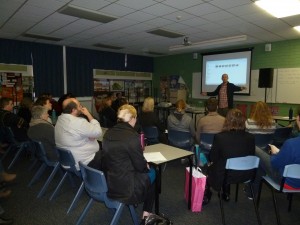It’s a fast-moving juggernaut. It can’t and won’t stop for anyone, or anything. We’re powerless to stop it, to change it, or to even challenge it. Step in its path at your own peril—it won’t blink as it crashes through you.
It’s this digital world we find ourselves immersed in.
The invitation to ‘grab your bibles and let’s read from Mark chapter one’ results in people reaching into their pockets, drawing out a smartphone, opening a Bible application, and scrolling to Mark (Either that, or they’re all updating Facebook or Twitter status).
Young people live in these digital spaces: yet there is one ancient practice, one ages-old discipline that engages them in deep and transformative ways.
I gaze out at the group of high school students in front of me, unusually hushed and actually straining to hear what I’m going to say next. It throws me a little. I pause briefly in my re-telling of the story of Jesus and the woman caught in adultery as I savour this unique moment. A few hundred un-churched young people having their imaginations engaged as they listen to a Bible story.
I continue: “Then this woman, still lying in the dirt, naked, ashamed, shaking uncontrollably with sheer terror, realises that the angry male voices have stopped. Everything is quiet. She looks up, and there’s Jesus—the other men have quietly walked away. Jesus reaches down to her and helps her to her feet, and wraps a cloak around her”.
“Go Jesus!” shouts one of the students. Everyone laughs. There’s a sense of relief that Jesus—as they had hoped—stood up for this marginalised woman. I finish the story, and at the end of the seminar several students wander over to me to ask me questions. “Why did these men hate Jesus so much if he helped people,” one asks. Another asks, “If this woman was caught having sex with a man—what happened to him?” They’re great, thoughtful questions.
A story well told engages the imagination of a young person; it enables them to identify with the characters and the plot of the story, essentially bringing a story to life.
When I speak to young people at camps, schools, or other youth events, I use video clips, music and social media to engage them, but I have come to believe that good storytelling is one of the most powerful ways to engage young people. And it doesn’t require any technology.
When it comes to some of the familiar Bible stories, I love to read about what life was like back then, what was happening in that time and that place, what was shaping their culture, why were things the way they were? As the story starts to come to life in my imagination, I’m able to re-tell that story from my imagination to others in the hope that they too can hear it in a new and fresh way. Hopefully, some of their assumptions of the story are challenged and it begins to make sense and even challenge them.
“Storytellers have as profound a purpose as any who are charged to guide and transform human lives. I knew it as an ancient discipline and vocation to which everyone is called.”
Nancy Mellon, The Art of Storytelling
We all have the ability to be good storytellers. Jesus was the ultimate storyteller. He knew his audience, he engaged their imaginations, and he invited them to ‘enter’ the story and wrestle with it, to think about it, to ask questions of the story.
My encouragement to you is to source some good Bible commentaries, choose one of your favourite stories of Jesus and explore the culture and context around the story. Then imagine you are there. Describe what you see, hear and feel. Tell that story as if you are in it – that’s the art of storytelling.
Adrian Blenkinsop works with Bible Society Australia. His passion is to see young people engage with the Bible in ways that transform them and their communities. He spends his time doing public speaking at leadership and youth events, schools and churches, and developing resources to enable young people to engage with the Bible.
If you’d like to connect with Adrian, email him at Adrian.blenkinsop@biblesociety.org.au
Email This Story
Why not send this to a friend?

